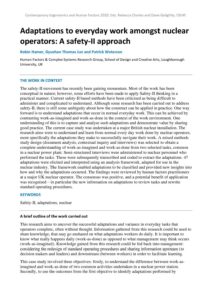| Document | Author Robin Hamer, Gyuchan Thomas Jun and Patrick Waterson |
| Abstract The safety-II movement has recently been gaining momentum. Most of the work has been conceptual in nature; however, some efforts have been made to apply Safety-II thinking in a practical manner. Current safety-II based methods have been criticised as being difficult to administer and complicated to understand. Although some research has been carried out to address safety-II, there is still some ambiguity about how the construct can be applied in practice. One way forward is to understand adaptations that occur in normal everyday work. This can be achieved by contrasting work-as-imagined and work-as-done in the context of the work environment. One understanding of this is to capture and analyse such adaptations and demonstrate value by sharing good practice. The current case study was undertaken at a major British nuclear installation. The research aims were to understand and learn from normal every day work done by nuclear operators, more specifically the adaptations they make to successfully navigate their work. A mixed methods study design (document analysis, contextual inquiry and interviews) was selected to obtain a complete understanding of work-as-imagined and work-as-done from two selected tasks, common in a nuclear power plant. Semi-structured interviews were administered to nuclear personnel who performed the tasks. These were subsequently transcribed and coded to extract the adaptations. 47 adaptations were elicited and interpreted using an analysis framework, adapted for use in the nuclear industry. The framework enabled adaptations to be classified and provided new insights into how and why the adaptations occurred. The findings were reviewed by human factors practitioners at a major UK nuclear operator. The consensus was positive, and a potential benefit of application was recognised – in particular the new information on adaptations to review tasks and rewrite standard operating procedures. |

